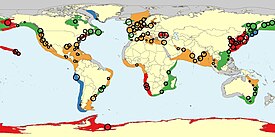
Increase (high certainty)
Increase (low certainty)
Stable/variable
Decrease
No data
Population ecology is a sub-field of ecology that deals with the dynamics of species populations and how these populations interact with the environment, such as birth and death rates, and by immigration and emigration.[2]
The discipline is important in conservation biology, especially in the development of population viability analysis which makes it possible to predict the long-term probability of a species persisting in a given patch of habitat.[3] Although population ecology is a subfield of biology, it provides interesting problems for mathematicians and statisticians who work in population dynamics.[4]
- ^ Brotz, Lucas; Cheung, William W. L; Kleisner, Kristin; Pakhomov, Evgeny; Pauly, Daniel (2012). "Increasing jellyfish populations: Trends in Large Marine Ecosystems". Hydrobiologia. 690 (1): 3–20. doi:10.1007/s10750-012-1039-7.
- ^ Odum, Eugene P. (1959). Fundamentals of Ecology (Second ed.). Philadelphia and London: W. B. Saunders Co. p. 9, 546. ISBN 9780721669410. OCLC 554879.
- ^ AAAS Atlas of Population and Environment
- ^ Kingsland, S. (1995). Modeling Nature: Episodes in the History of Population Ecology. University of Chicago Press. ISBN 978-0-226-43728-6.